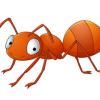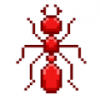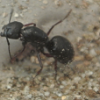- Formiculture.com
- Forums
- Gallery
- Members
- Member Map
- Chat

How big is your largest ant colony?
Started By
Okiale
, Oct 31 2015 8:41 PM
12 replies to this topic
#1
 Offline
-
Posted October 31 2015 - 8:41 PM
Offline
-
Posted October 31 2015 - 8:41 PM
How big is your largest ant colony? How long have you had them and what species are they?
Civilization-the process by which a society or place reaches an advanced stage of social development and organization
ANTS
ANTS
#2
 Offline
-
Posted October 31 2015 - 9:02 PM
Offline
-
Posted October 31 2015 - 9:02 PM
Tetramorium sp. E at about 300 workers. I have had the queen for about a year but, they are heavily brood boosted
Edited by Mdrogun, October 31 2015 - 9:02 PM.
Currently Keeping:
Trachymyrmex septentrionalis
Pheidole pilifera
Forelius sp. (Monogynous, bicolored) "Midwestern Forelius"
Crematogaster cerasi
Pheidole bicarinata
Aphaenogaster rudis
Camponotus chromaiodes
Formica sp. (microgena species)
Nylanderia cf. arenivega
#3
 Offline
-
Posted October 31 2015 - 9:54 PM
Offline
-
Posted October 31 2015 - 9:54 PM
Probably my Pheidole megacephala. Only 100-200 workers, not sure how many queens, definitely one though. I've had them for a month and a half now I believe. A lot better start to this species, because usually, I guess, I get too many queens and they expand too fast. Plus, they seem to slow down a bit in Winter here.
#4
 Offline
-
Posted November 1 2015 - 6:59 AM
Offline
-
Posted November 1 2015 - 6:59 AM
Temnothorax sp 60 (if i wanted i was about to get at least 200 pupae from other nests but i was thinking about it and i don't want destroy the colonys) workers and lasius sp 45 workers (without brood boost),and formica fusca 40 workers (20 nanitics).
#5
 Offline
-
Posted November 1 2015 - 7:32 AM
Offline
-
Posted November 1 2015 - 7:32 AM
My largest colony is Crematogaster cerasi, at around 500 workers. My next largest colony is Camponotus novaeboracensis.
I often update my list of colonies on the Census page - http://www.formicult...he-forum/?p=924
- ctantkeeper likes this
"Always do right. This will gratify some people, and astound the rest." -- Samuel Clemens
#6
 Offline
-
Posted November 1 2015 - 8:30 AM
Offline
-
Posted November 1 2015 - 8:30 AM
my largest colony is about 180 workers strong. its lasius neoniger ![]()
#7
 Offline
-
Posted November 1 2015 - 9:49 AM
Offline
-
Posted November 1 2015 - 9:49 AM
My largest is Tetramorium sp.e and they are probably over a thousand strong now.
- ctantkeeper likes this
#8
 Offline
-
Posted November 2 2015 - 3:40 PM
Offline
-
Posted November 2 2015 - 3:40 PM
Wow you guys have huge colonies LOL. In terms of mass, my Camponotus modoc colony has approximately 30 workers while my Lasius alienus ants have between 75-90.
Here's my leopard gecko/ant youtube: https://goo.gl/cRAFbK
My ant website.
It contains a lot of information about ants, guides, videos, links, and more!
If you have any feedback, please post here or PM me, don't be shy!
I currently keep:
Formica podzolica
#9
 Offline
-
Posted November 2 2015 - 7:26 PM
Offline
-
Posted November 2 2015 - 7:26 PM
Wow you guys have huge colonies LOL. In terms of mass, my Camponotus modoc colony has approximately 30 workers while my Lasius alienus ants have between 75-90.
Give your colonies around 3-4 years. Then if you are still around you can amaze people just coming into the hobby. ![]()
- ctantkeeper likes this
"Always do right. This will gratify some people, and astound the rest." -- Samuel Clemens
#10
 Offline
-
Posted November 3 2015 - 6:31 AM
Offline
-
Posted November 3 2015 - 6:31 AM
Veromessor pergandei.
1 year 8 months.
Well over 1500.
- Martialis likes this
#11
 Offline
-
Posted November 3 2015 - 2:04 PM
Offline
-
Posted November 3 2015 - 2:04 PM
Wow you guys have huge colonies LOL. In terms of mass, my Camponotus modoc colony has approximately 30 workers while my Lasius alienus ants have between 75-90.
Give your colonies around 3-4 years. Then if you are still around you can amaze people just coming into the hobby.
Or you could find a queen of the most common species in your area and brood boost her a ton.
Currently Keeping:
Trachymyrmex septentrionalis
Pheidole pilifera
Forelius sp. (Monogynous, bicolored) "Midwestern Forelius"
Crematogaster cerasi
Pheidole bicarinata
Aphaenogaster rudis
Camponotus chromaiodes
Formica sp. (microgena species)
Nylanderia cf. arenivega
#12
 Offline
-
Posted November 4 2015 - 8:03 AM
Offline
-
Posted November 4 2015 - 8:03 AM
Give your colonies around 3-4 years. Then if you are still around you can amaze people just coming into the hobby.
Or you could find a queen of the most common species in your area and brood boost her a ton.
True, I did that once when first starting out. To be honest, it is not as rewarding as letting your queen do all the work. In many places, commo species have several close look alikes that can be hard to ID, and mixing species can lead to problems like brood eating, etc.
"Always do right. This will gratify some people, and astound the rest." -- Samuel Clemens
#13
 Offline
-
Posted November 8 2015 - 2:36 PM
Offline
-
Posted November 8 2015 - 2:36 PM
Well, I got a colony of Monomorium ergatogyna with over 10,000 workers and dozens of queens (most likely over 50 like I said in my new journal about them). I had to get them out of the plant pot on the porch or mom was going to drown them in soapy water. I've only had them today, but M. ergatogyna colonies get huge. Really easy to keep, BUT are the best escape artists of any ant species I've ever had. Even better than Solenopsis molesta.
They also make huge giant colonies that stretch out for a long ways. One colony I had to walk literally 5 minutes from one edge of their colony to the other, and that didn't include the entire hillside they controlled.
And the only native ant I've seen that displaces Argentine ants and completely or removes 99% of them from an area once their colonies mature and get big. Solenopsis invicta can't even beat M. ergatogyna, but they don't get displaced as much compared to Argentine ants.
- Martialis likes this
1 user(s) are reading this topic
0 members, 1 guests, 0 anonymous users




















